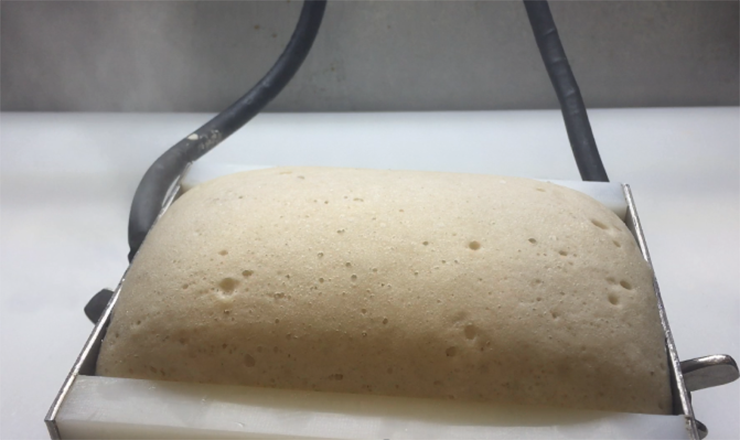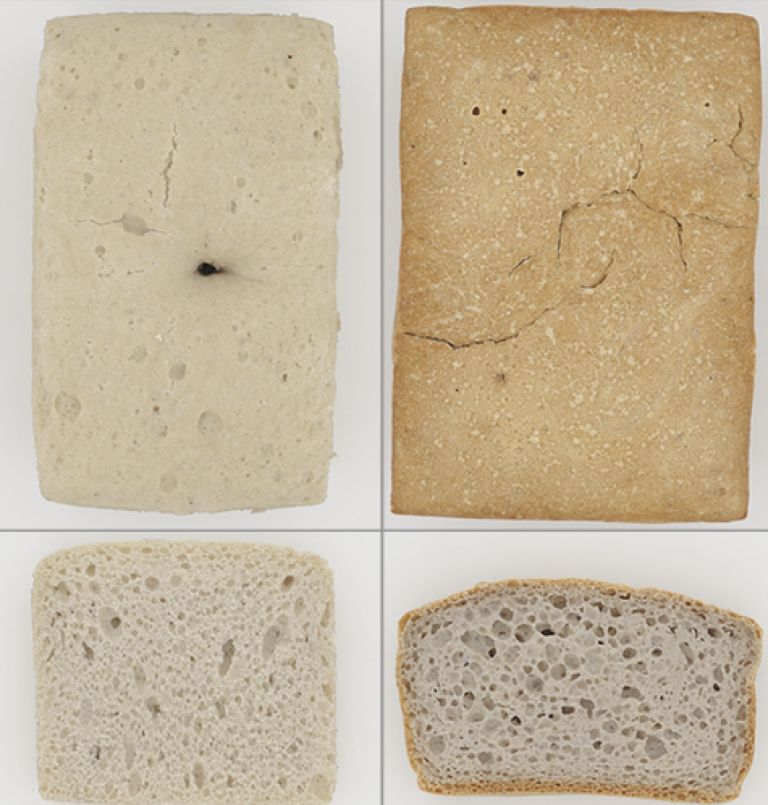
Ohmic heating is a process in which a product is connected in an electrical circuit like a resistance and is heated as a result. At the BOKU in Vienna, this technology is being tested for bread baking, specifically for gluten-free bread.
Up to now, ohmic heating has been used in the food industry mainly for sterilization etc. It functions in seconds, but depends on various product properties, including water and salt content, pH etc. A team of researchers at the BOKU in Vienna/Austria (University of Natural Resources and Life Sciences) has tackled the question as to whether it makes sense to use it for baking bread, specifically gluten-free bread. An interview with Regine Schönlechner and Denisse Bender.
Hildegard M. Keil: What motivated you or your research group to use this heating technique for bread, which as a general rule undergoes a process during baking, namely oven spring, that is part of the development of its structure and crust? What advantages could ohmic heating provide compared to heat transfer via contact or convection?
BOKU: Gluten-free doughs need a larger water content compared to doughs containing wheat, and are thus a challenge for bakeries simply due to this different texture: liquid/pumpable dough (similar to cake dough) for gluten-free doughs, compared to firm, “free-standing” doughs for wheat doughs.
However, this pumpable, more fluid dough texture is exactly the ideal precondition for ohmic baking. That’s why we tested it quite spontaneously, in a simple experiment, and this initial attempt astonished us: the volume of the gluten-free bread heated in this way was many times greater than that of the same breads baked in a conventional oven. Subsequently, therefore, we worked on determining the parameters (power, time etc.) more precisely.
One of the advantages of ohmic heating is that the dough heats volumetrically. Heat is uniformly distributed within the bread (there are only minimal temperature differences within the product), and the baking process is accelerated.

Ohmic heating of a piece of dough between two electrodes in an ohmic baking chamber
Keil: In your most recent study, you concentrated in producing gluten-free breads based on buckwheat flour and starch. What idea lay behind it?
BOKU: Most of the gluten-free breads available on the market are based on very starch-rich raw materials, or on pure starch, and therefore contain relatively low levels of dietary fiber, minerals and vitamins. Our aim in the research into gluten-free products was always to make them more nutrient-rich. Using wholegrain flours and/or using nutrient-rich, gluten-free flours offers a good opportunity to achieve this. Flours made from pseudo-cereals (amaranth, quinoa and buckwheat) or varieties of millet are good examples of this, and we have studied all of these. Since buckwheat flour is also an indigenous product in this country, however, we gave preference to this flour for many of the experiments.
Keil: If I have understood it correctly, the baking process consisted of three stages in which the heat was reduced in a stepwise manner. Could you please explain to us where the advantages lie compared to a single unvarying heating process?
BOKU: The stepwise reduction in the electric power (not the heat!) is necessary because otherwise the doughs/breads would burn in the ohmic oven. The initial high-power step is the actual baking step: a dough temperature of more than 90°C is reached within a few seconds and the bread is baked right through, the dough expands and the crumb of the bread is formed. After these few seconds, however, the bread crumb is still rather too moist; the water content is still too high and/or the bread crumb is still too moist, chiefly at the margins (at the zones of contact with the pan). Further heating is still needed here, although burning must be prevented at the same time. This optimization was one of the biggest challenges, and we succeeded through a stepwise reduction in the power.
Keil: How long does a baking process of this kind last, and to what extent does it depend on the weight and volume of the dough?
BOKU: The total duration of the entire baking process is between 25 seconds and 2 minutes, and depends mainly on the water content. Weight and volume have scarcely any influence on baking time, as long as the total amount of energy flowing through the dough is held constant. I.e., if an increased weight of dough is required, only the power needs to be adapted/increased to arrive at the same baking time.
Keil: How did the volume, color, structure and crumb moisture content of the breads develop during the baking process?
BOKU: A crumb structure formed very quickly as a result of using the ohmic heating process (in about 30 seconds to 2 minutes). At the same time, the final bread volume was larger than for breads baked in a conventional oven. The crumb was very open, and also dry as a result of holding for a slightly longer time at a lower energy input. This means the breads were ready to eat after a very short time. In contrast to bread baked conventionally, however, the baked bread does not develop any crust.

Crust and crumb of a gluten free buckwheat bread baked with ohmic heating (left) and obtained from conventional baking (right)
Keil: Does the process affect the ability to bind water, and thus to the impression of freshness and/or retrogradation of the breads?
BOKU: Breads produced using ohmic baking are unbelievably light and succulent. However, there is still a need to carry out accurate studies of the shelf life and storability of the breads.
Keil: Were you able to define an optimum baking process, and/or a complete optimum production process?
BOKU: As a result of numerous experiments, we succeeded in defining an ohmic baking procedure in which the breads were optimally baked all through without burning.
Keil: What is your estimate of the comparison with regard to costs between heat transfer through ohmic heating vis-à-vis contact/convection?
BOKU: The baking process consumes at least 50% less energy than a conventional baking process. Moreover, ohmic heating needs no preheating as in the case of a usual baking oven, which takes at least 15 minutes to reach baking temperature (180°C).
Keil: Are the results transferable to all gluten-free products, irrespective of their raw materials basis?
BOKU: Basically, this process is applicable to all doughs and batters that have a similar recipe, i.e. sufficient fluidity and viscosity (defined mainly by the water content). It is important that the batter has sufficient electrical conductivity, although this is ensured by adding at least 0.5% of salt (relative to the flour). Breads usually contain at least 1.5% of salt.
Keil: Many thanks for our discussion.


